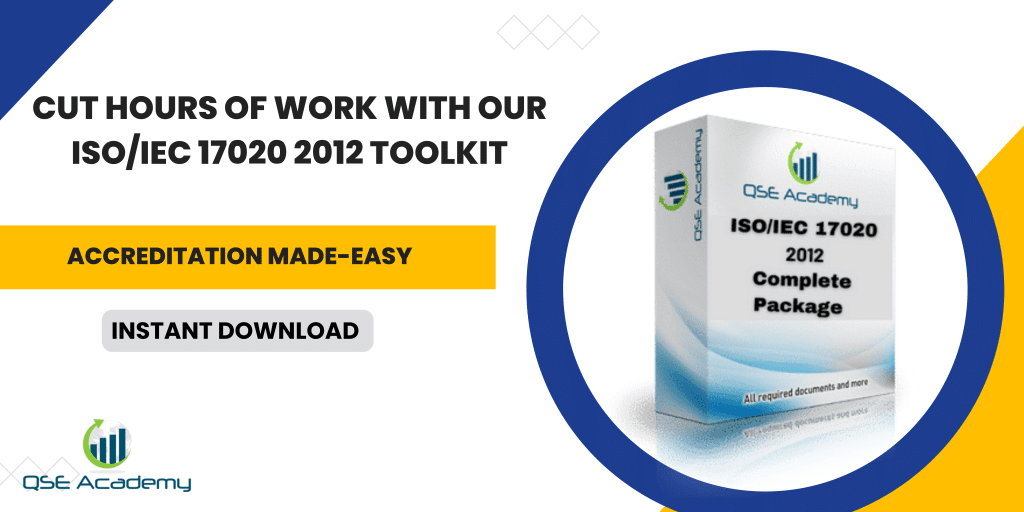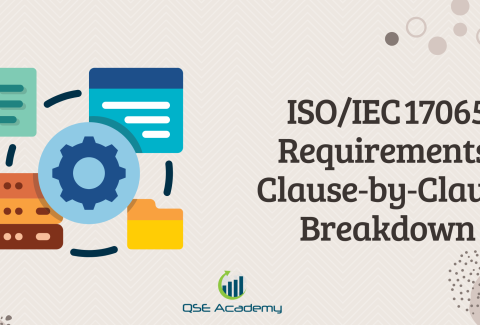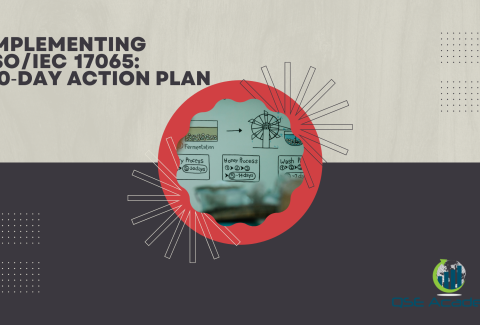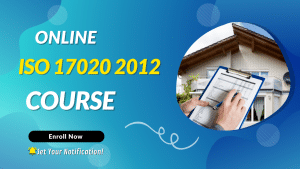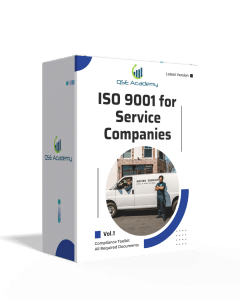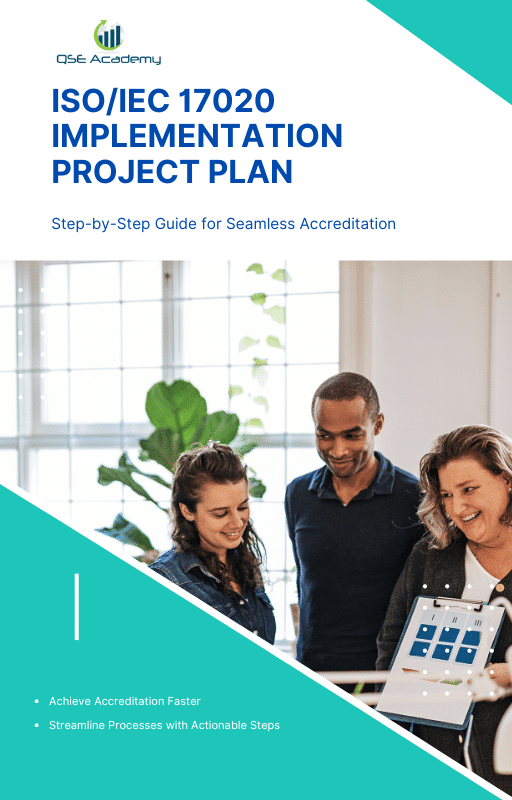ISO/IEC 17020 Implementation on a Small‑Business Budget
Last Updated on October 22, 2025 by Hafsa J.
Proving Compliance Without Breaking the Bank
Every small inspection body faces the same challenge: how to meet ISO/IEC 17020 requirements without draining the budget.
I’ve seen it countless times — small teams trying to balance day-to-day operations while figuring out how to document, train, and prepare for accreditation.
The truth? You don’t need a big budget to build a compliant, credible system. What you need is focus, resourcefulness, and structure.
Most of the expensive tools and consulting hours are nice-to-haves, not must-haves.
In this guide, I’ll show you exactly how small inspection bodies can implement ISO/IEC 17020 step by step — using what you already have, spending only where it matters, and still achieving a fully audit-ready system.
By the end, you’ll know where to start, what to skip, and how to prove competence without overspending.
Understanding the Real Cost of ISO/IEC 17020 Implementation
When people hear “ISO accreditation,” they often imagine huge budgets, consultants flying in, and months of documentation.
But here’s the reality — most small inspection bodies can achieve ISO/IEC 17020 compliance with a fraction of that cost, if they understand where the money really goes.
Let’s break it down.
Typical Cost Areas:
-
Documentation development: Writing your quality manual, procedures, and forms.
-
Training: Teaching staff about ISO/IEC 17020 and their specific roles.
-
Internal audits: Performing a system check before the external audit.
-
Accreditation application & assessor fees: Usually the biggest unavoidable expense.
What’s interesting is that only the last one — the accreditation body fee — is fixed. Everything else is flexible.
You can build your own documentation, train your team internally, and even conduct internal audits using free or low-cost tools.
Pro Tip: Spend money where it directly impacts compliance — like staff competence or impartiality risk control — not on polished documents or branded binders. Assessors care about how you work, not how your manual looks.
Common Pitfall: Buying expensive “ISO packages” without customization. Templates help, but they only work when adapted to your actual operations.
Once you understand what’s essential and what’s not, ISO/IEC 17020 implementation becomes a cost-managed project, not a financial burden.
Start with What You Already Have (Gap Analysis & Resource Mapping)
Most small inspection bodies are already halfway to ISO/IEC 17020 compliance — they just don’t realize it yet.
You probably already have processes for training, reporting, safety, and equipment control. The challenge is that they’re not formally documented or linked to the standard.
That’s where a gap analysis comes in. It’s your cheapest, most powerful starting point.
Here’s how to do it:
-
List all existing processes and records.
Things like checklists, inspection reports, calibration certificates, or complaint logs — they all count. -
Compare them to ISO/IEC 17020 clauses.
Ask three simple questions for each clause:-
Do we already do this?
-
Is it documented?
-
Do we have records to prove it?
-
-
Mark your gaps clearly.
Use a simple Excel sheet with three columns: Compliant, Partially Compliant, Not Yet Compliant. -
Assign responsibilities.
Even if your team is small, every gap needs an owner — it keeps the plan moving.
Pro Tip: Don’t start by writing new procedures. Start by collecting what already exists and adapting it. You’ll be surprised how much is usable once you format it properly.
Example:
A client once realized their daily vehicle inspection log actually covered part of Clause 7 (inspection methods). They just needed to rename it and include version control. Cost? Zero.
Doing a realistic gap analysis helps you spend smarter — fixing only what’s missing instead of rebuilding everything from scratch.
Prioritize High-Impact Clauses (Where Small Businesses Should Focus First)
If you’re working with limited time or money, you can’t afford to treat all ISO/IEC 17020 clauses equally.
Some have a bigger impact on accreditation — and skipping them can cost you later.
Here’s where small inspection bodies should focus first:
Clause 4 – Impartiality and Independence
This is one of the first things assessors look for.
You need to prove that inspection results are objective, that staff are free from external influence, and that there’s a policy in place to manage conflicts of interest.
It doesn’t have to be fancy — a one-page impartiality statement and a declaration form per employee can do the job.
Clause 6 – Resources and Competence
Accreditation bodies want assurance that your people know what they’re doing.
Document your training records, qualifications, and authorizations. If you can show a simple competence matrix, you’re already meeting most of this clause.
Clause 7 – Inspection Methods and Procedures
Your core business. Make sure your methods are clear, repeatable, and traceable. Even if you only have a few types of inspection, document each one with purpose, scope, equipment, and steps.
Clause 8 – Management System Requirements
This is your backbone — internal audits, corrective actions, and management reviews.
Don’t overcomplicate it. Use a single spreadsheet to track nonconformities and actions.
Pro Tip: Focus on evidence over elegance. Assessors prefer simple, real examples that show control — not overly formatted documents that no one uses.
By prioritizing these four areas, you’ll cover about 80 % of what matters in your first accreditation attempt — without wasting a cent on low-impact paperwork.
Building ISO/IEC 17020 Documentation on a Budget
Documentation often intimidates small businesses — it sounds expensive, time-consuming, and technical.
But here’s the good news: you don’t need fancy software or consultants to create ISO/IEC 17020 documents that auditors will respect.
Start small, stay organized, and write only what’s necessary.
Step 1: Use Simple Tools You Already Know
Word, Excel, or Google Docs are more than enough.
Create a shared folder structure — one for policies, one for procedures, and one for records. Add basic version control (date, version number, and approved by).
Step 2: Focus on the Core Documents First
You can build a solid system with just these essentials:
-
Quality Manual or Policy Statement – A short document describing your organization, scope, and commitment to impartiality.
-
Procedures – For document control, impartiality, competence, internal audit, corrective action, and reporting.
-
Forms and Templates – Checklists, training records, inspection reports, and nonconformity logs.
Pro Tip: Keep procedures practical. If your team can’t follow them easily, they’ll be ignored — and that’s worse than not having them at all.
Step 3: Reuse What Exists
Instead of writing from scratch, adapt existing company procedures. For example:
-
Your safety or calibration procedures might already meet ISO documentation needs.
-
Convert old Excel logs into “controlled forms” by adding headers and revision numbers.
Step 4: Keep It Modular
Write short, focused procedures instead of one giant manual. That way, you can update parts easily without breaking the whole system.
Common Pitfall: Copying generic templates from the internet word-for-word. Assessors can spot it instantly — and they’ll ask questions your team can’t answer.
When your documentation is concise, relevant, and easy to maintain, it won’t just meet ISO 17020 — it’ll make your daily operations smoother.
Training & Competence Development Without Big Expenses
Training doesn’t have to mean expensive courses or consultants.
For small inspection bodies, the goal is to build competence using what you already know and what’s freely available.
Here’s how to do it effectively — and affordably.
1. Start with Internal Mentoring
Your senior inspectors are your best trainers.
Have them demonstrate inspection steps, explain decision-making, and share real examples.
Hands-on learning is not only cheaper — it’s far more relevant than a generic ISO course.
Pro Tip: Turn one-on-one mentoring into official “training.” Just document it — date, topic, trainer, and trainee signatures. It counts as valid evidence for assessors.
2. Use Free or Low-Cost Learning Resources
You don’t need a training budget to learn the basics.
-
Accreditation bodies often provide free webinars or publications explaining ISO/IEC 17020 requirements.
-
Online platforms like Coursera or YouTube have free tutorials on audit preparation, document control, and inspection processes.
-
QSE Academy’s guides and templates can serve as structured self-training tools.
Pro Tip: Combine short online sessions with practical demonstrations — that mix keeps training realistic.
3. Collaborate With Other Small Businesses
If you know other inspection bodies in your industry, share training costs.
You can organize joint workshops, split consultant fees, or simply trade peer assessments.
Collaboration reduces cost and builds stronger professional relationships.
4. Build and Maintain a Simple Competence Matrix
Track everyone’s qualifications, training, and authorization in one spreadsheet.
Columns can include: Name, Role, Training Completed, Competence Verified, Authorized Activities.
That one document satisfies multiple clauses at once (Clause 6.1 & 6.2) — assessors love seeing it.
Common Pitfall: Skipping training documentation. Even informal or internal sessions need a record. If it’s not documented, it doesn’t exist during an audit.
Competence isn’t built by spending — it’s built by structure, repetition, and proof.
Free or Low-Cost Tools to Manage Implementation
You don’t need expensive ISO software to manage your project or documents.
Plenty of free or affordable tools can help you organize your implementation — and most are easier to use than enterprise systems.
Here’s how to set up a simple digital toolkit that keeps everything on track.
1. Use Cloud Platforms for Document Control
Google Workspace or Microsoft 365 is perfect for small teams.
-
Store your procedures, templates, and records in shared folders.
-
Control access (view or edit) based on roles.
-
Track version history automatically.
Pro Tip: Create a “master folder” named ISO/IEC 17020 Management System with subfolders for each clause. That structure makes it easy for assessors to navigate during audits.
2. Manage Projects with Free Planning Tools
You can use:
-
Trello – to assign tasks, track deadlines, and monitor progress.
-
Notion – for combining documentation, notes, and checklists.
-
ClickUp or Asana – for free project tracking if you prefer Gantt-style views.
Example: One inspection company I helped used Trello to manage its ISO 17020 implementation. Each card represented a clause, with subtasks for documents, audits, and reviews. The whole project stayed on track — and cost nothing.
3. Track Audits and KPIs in Excel
You don’t need specialized QMS dashboards.
Use a simple spreadsheet to track:
-
Internal audits and findings.
-
Nonconformities and corrective actions.
-
Key performance indicators (on-time reports, customer feedback, complaint resolution).
Pro Tip: Use color coding (Red = Needs Action, Yellow = In Progress, Green = Complete). It’s simple and visual — auditors love clarity.
4. Consider Scalable SaaS Tools (Optional)
If you want something more integrated later, affordable platforms like QSE Academy’s ISO 17020 SaaS can automate document control, competence tracking, and internal audits — without enterprise-level pricing.
Common Pitfall: Using too many apps. Choose one or two tools and master them. Simplicity saves time, and consistency builds confidence.
When your tools fit your workflow, ISO implementation stops feeling like admin work and starts running smoothly — even on a tight budget.
Smart Outsourcing – When (and What) to Pay For
You can do a lot in-house, but there are times when spending a little saves a lot — especially when expertise or objectivity matters.
The trick is knowing when to outsource and when to keep things internal.
Here’s how small inspection bodies can use outsourcing strategically without overspending.
1. Invest in Pre-Accreditation Review, Not Full Consulting
You don’t need a consultant writing your entire system — you need one to review what you’ve built.
A short pre-assessment (usually a one- or two-day review) can help you spot compliance gaps before the accreditation body does.
Pro Tip: Hire by the hour or per deliverable. Ask for targeted help, like reviewing your impartiality procedure or preparing your internal audit plan.
2. Pay for What You Can’t Legally or Technically Do
Certain tasks must be handled by recognized professionals.
-
Calibration: Always use an accredited lab.
-
Legal reviews: Get professional input if your inspection activities involve contracts, liability, or confidentiality risks.
-
Impartiality committee: You can invite external members instead of hiring them.
Those costs are minimal compared to the potential impact of nonconformities in these areas.
3. Outsource Training Strategically
Instead of full workshops, purchase short online modules or invite an expert for a single day to train your team on specific topics like internal audits or risk-based thinking.
It’s far cheaper than bringing in a consultant for a full implementation package.
Example: One small inspection body I worked with paid $300 for a half-day internal audit course. That session helped them save $2,000 by performing their own audits later.
4. Collaborate Instead of Hiring
If you’re connected with other small inspection firms, consider cost-sharing agreements.
You can share external auditors, trainers, or even impartiality committee members.
Common Pitfall: Outsourcing everything “to save time.” It ends up costing more and leaves your team detached from the system. Do 80% in-house, outsource 20% strategically.
Outsourcing smartly gives you expert assurance where it matters most — while keeping full control of your system and your budget.
Keeping the System Alive After Accreditation (Maintaining Compliance Cheaply)
Getting accredited is one thing — staying compliant is where most small businesses stumble.
Once the certificate is on the wall, enthusiasm fades, and procedures quietly collect dust. But maintaining ISO/IEC 17020 doesn’t have to be costly or complicated.
Here’s how to keep your system active and effective without adding extra workload or expense.
1. Integrate ISO Activities Into Daily Operations
Don’t treat your management system as something separate.
Internal audits, document reviews, and competence checks should flow naturally from your everyday work.
For example:
-
Review your impartiality declaration during staff meetings.
-
Record equipment calibration dates in your usual maintenance log.
-
Discuss audit findings as part of your regular operations meeting.
When ISO tasks become habits, you don’t need reminders or extra staff time.
2. Schedule Mini Internal Audits
Instead of one big annual audit, spread it across the year.
Audit one or two clauses every month — it’s faster, less stressful, and helps catch issues early.
Pro Tip: Rotate responsibilities. Train multiple staff members to perform internal audits, even informally. It builds ownership and saves money on external auditors.
3. Hold Short, Focused Management Reviews
You don’t need formal boardroom meetings with thick reports.
Gather key staff quarterly for 30 minutes to discuss:
-
Nonconformities and corrective actions.
-
Client feedback and complaints.
-
Opportunities for improvement.
Record the minutes, list actions, and you’ve just met Clause 8.7 — no extra cost, no formality required.
4. Use Simple KPI Tracking
Monitor performance with 3–5 metrics that actually matter, such as:
-
Number of inspections completed on time.
-
Client satisfaction rate.
-
Number of nonconformities closed within deadline.
Track them in Excel or Google Sheets. It keeps your system measurable and shows continual improvement — exactly what assessors want to see.
5. Refresh Training Gradually
You don’t need new training sessions every month.
Add quick refresher talks during toolbox meetings or after internal audits. Even a 10-minute discussion counts if you record it.
Common Pitfall: Ignoring the system until the next audit date. When ISO becomes part of your workflow, not a yearly project, it stays efficient, affordable, and alive.
FAQs – Common Questions About ISO/IEC 17020 Implementation on a Budget
Q1: Can a small inspection body really achieve ISO/IEC 17020 without hiring a consultant?
Absolutely. Many small firms do it successfully with the right templates, clear guidance, and consistent internal effort.
Consultants make the process faster, but not mandatory. If your team is organized and willing to learn, you can implement 80–90% of the requirements in-house.
Pro Tip: Invest in a good starter toolkit — like procedures, forms, and checklists — then customize everything to your own operations.
Q2: What’s the realistic cost range for small-scale implementation?
Most small inspection bodies spend between $3,000 and $8,000 total, including accreditation fees.
Your biggest costs are usually training and the accreditation body’s audit fees — not the implementation itself.
If you handle documentation internally and use free tools, your only real expense is external assessment.
Q3: How long does it take to become audit-ready on a small budget?
For most small teams, 8 to 12 weeks is realistic.
It depends on your current documentation and how consistently you work on it.
Set weekly goals: one or two clauses at a time, with a short review every Friday. Steady progress beats rushed paperwork every time.
Q4: What’s the biggest mistake small businesses make when trying to save money?
Cutting corners on competence and impartiality.
Assessors are flexible about document style but strict about training, independence, and consistency.
It’s fine to write your own procedures — but every inspector must be trained and authorized properly, and impartiality risks must be managed.
Pro Tip: Always focus resources where evidence matters most — training, impartiality, and records.
A smart budget isn’t about cutting costs everywhere — it’s about spending where it counts and documenting everything else with discipline.
Small Budget, Big Compliance
ISO/IEC 17020 implementation isn’t reserved for big organizations with big wallets.
Small inspection bodies can absolutely achieve accreditation — and often do it faster — because they’re lean, focused, and adaptable.
The truth is, compliance isn’t about how much you spend; it’s about how well you structure, document, and prove what you already do.
If your processes are sound, your people are competent, and your documentation is simple but clear, you’re already most of the way there.
Here’s what I’ve noticed after years of guiding small inspection firms:
Those who focus on consistency over perfection pass their audits with fewer findings — even without expensive systems.
Start with what you have. Improve what matters. Record what you do.
That’s the heart of ISO/IEC 17020, no matter your size or budget.
Next Step:
Download QSE Academy’s “ISO/IEC 17020 Small-Business Starter Toolkit” or schedule a quick consultation to turn your existing processes into an audit-ready system — at a fraction of the typical cost.
Because proving competence shouldn’t be expensive — it should just be done right.
I hold a Master’s degree in Quality Management, and I’ve built my career specializing in the ISO/IEC 17000 series standards, including ISO/IEC 17025, ISO 15189, ISO/IEC 17020, and ISO/IEC 17065. My background includes hands-on experience in accreditation preparation, documentation development, and internal auditing for laboratories and certification bodies. I’ve worked closely with teams in testing, calibration, inspection, and medical laboratories, helping them achieve and maintain compliance with international accreditation requirements. I’ve also received professional training in internal audits for ISO/IEC 17025 and ISO 15189, with practical involvement in managing nonconformities, improving quality systems, and aligning operations with standard requirements. At QSE Academy, I contribute technical content that turns complex accreditation standards into practical, step-by-step guidance for labs and assessors around the world. I’m passionate about supporting quality-driven organizations and making the path to accreditation clear, structured, and achievable.


